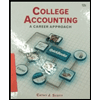
Concept explainers
Accounts receivable refers to the amounts to be received within a short period from customers upon the sale of goods and services on account. In other words, accounts receivable are amounts customers owe to the business. Accounts receivable is an asset of a business.
Bad debt expense:
Bad debt expense is an expense account. The amounts of loss incurred from extending credit to the customers are recorded as bad debt expense. In other words, the estimated uncollectible accounts receivable are known as bad debt expense.
Percentage-of-receivables basis:
It is a method of estimating the
Allowance method:
It is a method for accounting bad debt expense, where uncollectible accounts receivables are estimated and recorded at the end of particular period. Under this method, bad debts expenses are estimated and recorded prior to the occurrence of actual bad debt, in compliance with matching principle by using the allowance for doubtful account.
Write-off:
Write-off refers to deduction of a certain amount from accounts receivable, when it becomes uncollectible.
To Prepare: The
To Prepare: The journal entry in the book of Company D as on May 11, 2017.
To Prepare: The journal entry in the book of Company D as on June 12, 2017.
Want to see the full answer?
Check out a sample textbook solution
Chapter 8 Solutions
Financial Accounting: Tools for Business Decision Making, 8th Edition
- I need help finding the accurate solution to this general accounting problem with valid methods.arrow_forwardPlease provide the answer to this general accounting question with proper steps.arrow_forwardI am looking for help with this general accounting question using proper accounting standards.arrow_forward
- I am trying to find the accurate solution to this general accounting problem with the correct explanation.arrow_forwardCan you solve this general accounting problem with appropriate steps and explanations?arrow_forwardCan you solve this general accounting question with accurate accounting calculations?arrow_forward
- I am searching for the correct answer to this general accounting problem with proper accounting rules.arrow_forwardPlease explain the correct approach for solving this general accounting question.arrow_forwardPlease provide the correct answer to this general accounting problem using accurate calculations.arrow_forward
- Can you help me solve this general accounting question using valid accounting techniques?arrow_forwardPlease provide the solution to this general accounting question using proper accounting principles.arrow_forwardPlease explain the solution to this general accounting problem with accurate explanations.arrow_forward
 College Accounting (Book Only): A Career ApproachAccountingISBN:9781337280570Author:Scott, Cathy J.Publisher:South-Western College Pub
College Accounting (Book Only): A Career ApproachAccountingISBN:9781337280570Author:Scott, Cathy J.Publisher:South-Western College Pub College Accounting (Book Only): A Career ApproachAccountingISBN:9781305084087Author:Cathy J. ScottPublisher:Cengage Learning
College Accounting (Book Only): A Career ApproachAccountingISBN:9781305084087Author:Cathy J. ScottPublisher:Cengage Learning

